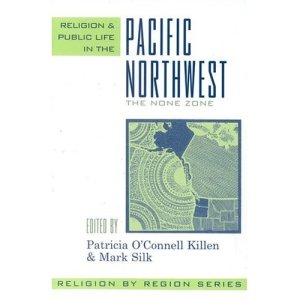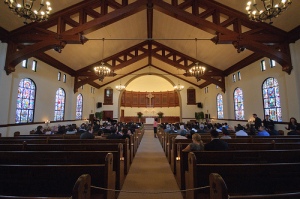Why do Evangelicals successfully start so many churches in the Pacific Northwest, asks scholar James Wellman, in an essay titled, “The Churching of the Pacific Northwest: The Rise of Sectarian Entrepreneurs” (included in Religion in the Pacific Northwest: The None Zone (http://www.amazon.com/Religion-Public-Life-Pacific-Northwest/dp/0759106258 ). Wellman, with adroit use of statistics, argues that the Pacific Northwest’s fecundity for Evangelical church planting springs primarily from its “none zone” status: our residents’ tendency to mark “none,” when asked about religious affiliation. The absence of a dominant denomination creates an “open religious market” in the eyes of Pacific Northwest (PNW) Evangelicals, where people are neither committed to nor hampered by denominational ties that would limit them from trying out and joining a new church, says Wellman.
But numerical statistics miss the most important part of the story of Evangelical entrepreneurs in the PNW. And that has to do with the cutting-edge style of new Evangelical churches in the PNW. Rather than the “None Zone,” it is the “Vogue Zone” that explains the thriving Evangelical church start scene in the Pacific Northwest. To his credit, Wellman notes the openness of PNW church-planting pastors to new media and contemporary worship practices. But these two factors, not really described nor explored by Wellman, don’t begin to explain why the Vogue Zone has a specific Evangelical identity, and has contributed to so many church starts. These Evangelical elements of the Vogue Zone include. . .
No Edifice Complex For Evangelicals, church buildings and their historic preservation are less important than creating spaces that are accessible and accommodating to those who might not otherwise consider the Gospel call. Evangelical faith has an intrepid quality, a restlessness to invite others to church, to assess one’s church by its growth in numbers, and to think strategically about neighborhoods as zones for evangelism. Consequently, in Evangelicalism we see intrepid, physical movement of congregations to new buildings, seeking better locations and facilities. These frequent moves foster an engine of style innovation, unhampered by the inert mass of a building that dictates style. For example, Imago Dei Community in Portland began with a small circle of fellow believers inviting friends and colleagues to their house worship gatherings – a common format for church starts. As the worshipping community grew, it purchased an old church building in Portland’s Laurelhurst neighborhood, a dark- timbered, vaulted ceiling church, illuminated by daylight streaming through stained glass windows depicting important biblical scenes – a sanctuary exquisitely in sync with Imago Dei’s sensual, spare and low-tech aesthetic.  Despite the beauty and historic allure of the Laurelhurst sanctuary, neighborhood street parking and the building’s seating ultimately could no longer hold the burgeoning congregation. So, the church rented a large auditorium at inner-city Franklin High School. Then, straining against that space, Imago Dei struck a deal to trade their old Laurelhurst property with Portland Four-Square Church’s campus, which had become too large for the shrinking Four-Square congregation. At each stop along the way Imago Dei has innovated its aesthetic, re-styling both the “dress” of the building and worship in a style that expresses Imago Dei’s values and experience of God.
Despite the beauty and historic allure of the Laurelhurst sanctuary, neighborhood street parking and the building’s seating ultimately could no longer hold the burgeoning congregation. So, the church rented a large auditorium at inner-city Franklin High School. Then, straining against that space, Imago Dei struck a deal to trade their old Laurelhurst property with Portland Four-Square Church’s campus, which had become too large for the shrinking Four-Square congregation. At each stop along the way Imago Dei has innovated its aesthetic, re-styling both the “dress” of the building and worship in a style that expresses Imago Dei’s values and experience of God.
The Creative Class There is a distinct Creative Class that is being drawn to Evangelicalism. Portland, Oregon is renown for its creative community’s work in film, writing and design. Some of the more distinguished among them have embraced Evangelicalism. While I can’t speculate on all the reasons within this essay, I would suggest two. First, Evangelicals’ contemporary style worship lowers barriers among the young creatives, who might not otherwise consider trying out church. Second, the conservative life-style of Evangelicals may appeal to creatives who have witnessed the destructive fall-out of substance abuse and casual sex among their peers.
The Willow Creek influence James Wellman calls the leaders of these Evangelical church-starts, “entrepreneurs,” and he is right, in that they are often unattached to the “capital” of a sponsoring denomination. But there is a sort of para-denomination that has had vast style influence among Evangelicals: Willow Creek Community Church, of the Chicago area. Willow Creek has evolved into functions that were previously carried out by denominations, particularly development of Christian Education curricula. Willow Creek’s curricula, used by an estimated 4000 churches, has a strong design identity, emphasizing graphic arts, teaching skits, recorded music, and compellingly designed publications, all packaged and integrated so that a church can, in essence, purchase a “style,” that is, the Willow Creek Style. (see http://www.christianitytoday.com/ct/2000/november13/5.62.html
Retail culture influences. “Seeker-friendly” Evangelical churches have taken not just a page, but the whole training manual from high service, high style retail business, what I have dubbed the “Lordstrom” phenomenon. (http://www.crosscurrents.org/swensonwinter2004.htm) The fashion-cum-service aesthetic of retail is liberally borrowed by Evangelicals. Information kiosks,  a cup of espresso, discreet digital information screens in the sanctuary that alert parents to the nursery, umbrellas at the doorways, free Bibles and simple sermon outlines, brilliantly attractive websites that are kept up-to-date – these are practices adapted from retail culture. This borrowing can occur because business is viewed positively by politically conservative Evangelicals, unlike the Mainline, where “capitalism” is routinely criticized, and fashion is specifically condemned as exploitative, superficial, and engaged in oppressive factory practices.
a cup of espresso, discreet digital information screens in the sanctuary that alert parents to the nursery, umbrellas at the doorways, free Bibles and simple sermon outlines, brilliantly attractive websites that are kept up-to-date – these are practices adapted from retail culture. This borrowing can occur because business is viewed positively by politically conservative Evangelicals, unlike the Mainline, where “capitalism” is routinely criticized, and fashion is specifically condemned as exploitative, superficial, and engaged in oppressive factory practices.
Fashion Loves Conservatism Conservative sexual ethics actually provide a safe space for fashion and its gendered performances. It is not uncommon to see skin-bearing sundresses, revealingly tight clothing, stiletto heels, of-the-moment hair and make-up, and other arch-feminine styling among Evangelical women at worship. At first I was stunned by this, expecting to see conservative style among these women. But I came to appreciate that Evangelical women assume that church is a safe space for this display of their beauty and its attributes, because this social space is bounded by conventions of Christian chastity – no one would assume that such clothing and appearance suggest sexual availability. Likewise, as the women pursue fashion, so too their men. Trendily bleached hair, earrings, the latest fashion in eyeglasses, boots, tight jeans, etc., are completely conventional garb for men.
If the Vogue Zone has such specific Evangelical sources, can the Mainline enter in? The Mainline’s respect for history and community roots prohibit the easy disposal of its buildings; the younger Creative Class is missing from its pews not because Mainline worship is “old” (ancient liturgy is experiencing a revival among young Evangelicals), but because it can be dowdy, lacking urgency and verve; Willow Creek materials will annoy many Mainliners because of their conservative theology; and business and fashion aren’t sources of inspiration and emulation for the Mainline, but enterprises demanding social criticism.
Is Mainline liberalism inextricably caught in its own “No Vogue Zone”?